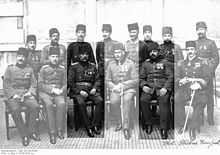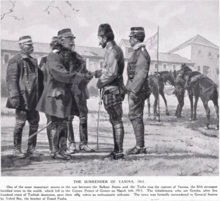- Wehib Pasha
-
 Mehmet Vehib (right) and his elder brother Esad Pasha (left)
Mehmet Vehib (right) and his elder brother Esad Pasha (left)
Vehib Pasha also known as Wehib Pasha, Vehip Pasha, Mehmed Wehib Pasha, Mehmet Vehip Pasha (modern Turkish: Kaçı Vehip Paşa or Mehmet Vehip (Kaçı), 1877–1940), was a general in the Ottoman Army. He fought in the Balkan Wars and in several theatres of World War I. in his later years, he acted as a military advisor to the Ethiopian army in the Second Italo-Abyssinian War.[1][2][3][4][5]
Contents
Biography
Vehib was born in 1877 in Yanya (present day: Ioannina), then located in the Ottoman Empire and now located in Greece. Coming from a prominent Albanian family of the city his father, Mehmet Emin Efendi, had served as the mayor of the city.[6] His elder brother Esad Pasha, who later took the surname Bülkat due to the Surname Act of the 1930s, defended Gallipoli in 1915, and Kâzım Taşkent was the founder of the Yapı Kredi that is the first nationwide private bank in Turkey. Vehib himself graduated from the Ottoman Imperial School of Military Engineering (Mühendishane-i Berrî-i Hümâyûn) in 1899, and then graduated from the Ottoman War Collage (Staff College, Mekteb-i Erkân-ı Harbiye-i Şâhâne) as a staff captain and joined the Fourth Army, which was then stationed in Yemen. In 1909, after the 31 March Incident, Vehib was called to Constantinople (Istanbul), where he began to work at the Ministry of War. Shortly afterwards Mahmud Shevket Pasha appointed Vehib as the Commander of the Cadet School (Military high school, Askerî İdadi). He reached the rank of Major.
Balkan wars
Main article: Battle of BizaniDuring the First Balkan War, Vehib defended the Fortress Yanya with his brother Esad Pasha who was the commander of the Yanya Corps, until February 20, 1913. The Ottoman forces surrendered to the Greeks under Crown Prince Constantine.
After his release as a prisoner of war, Vehib was made a Colonel in the 22nd Infantry Division. He was sent to Hejaz in Arabia.
First World War
The Ottoman Empire entered World War I and Vehib participated in the Gallipoli Campaign, commanding the XV Army Corps, and later the Second Army. His successes led to his being made commander of the Third Army during the Caucasus Campaign. His army held against attacks by the Russians but was defeated in the battle of Erzinjan. In 1918, Vehib's Third Army regained the offensive and took back Trabzon and Hora on February 24 as well as Batumi on March 26. With the Armistice of Mudros, Vehib returned to Constantinople (Istanbul).
War of Independence
Vehib did not participate in the Turkish War of Independence. After his return to Constantinople at the end of WWI, he was prosecuted for misuse of his office and jailed (Bekirağa Bölük). He escaped to Italy. His citizenship was revoked by the new government of the Turkey. He spent some time in Italy, Germany, Romania, Greece and Egypt. His dislike of Mustafa Kemal was well known and he never did hide his contempt for the new leader of Turkey who had once fought under his command at Gallipoli. He did not return back to Istanbul until after his death.[7]
Abyssinia
Vehib participated in the Second Italo-Abyssinian War where he was known as Wehib Pasha. He served as the Chief-of-Staff to Ras Nasibu, the Ethiopian Commander-in-Chief on the southern front. Vehib designed a strong defensive line for the Ethiopians which was known as the "Hindenburg Wall", in reference to the famous German defensive line of World War I, the Hindenburg Line. However, the Italians broke through these defenses during the Battle of the Ogaden in April 1936. Afterwards, Vehib left Ethiopia and returned to Istanbul.
He died in 1940 and was buried at Karacaahmet Cemetery in Istanbul.
Sources
- ^ "Eighth Month", Time magazine, May 4, 1936.
- ^ "Empire's End", Time magazine, May 11, 1936.
- ^ "Solemn Hours", Time magazine, October 14, 1935.
- ^ "Water Will Win", Time magazine, October 14, 1935.
- ^ "Newshawks, Seals", Time magazine, October 14, 1935.
- ^ Kayallof, Jacques (1973). The battle of Sardarabad. Mouton. p. 14. http://books.google.com/books?id=KVgrAAAAMAAJ&q=%22Both+he+and+his+brother,+Esat+Pasha%22&dq=%22Both+he+and+his+brother,+Esat+Pasha%22&hl=en&ei=c96dTrysN8r40gH1n7W-CQ&sa=X&oi=book_result&ct=result&resnum=1&ved=0CCwQ6AEwAA. Retrieved 18 October 2011.
- ^ Kevin Jackson, Atlas Tarih, No 03, September 2010, pp. 74-76.
External links
- Who is who (Turkish)
- Axis History Forum: Mehmet Vehib
Categories:- 1877 births
- 1940 deaths
- People from Ioannina
- Ottoman Imperial School of Military Engineering alumni
- Graduates of the Ottoman Military College
- Ottoman military personnel of the Balkan Wars
- Ottoman prisoners of war
- Balkan Wars prisoners of war held by Greece
- Ottoman Army generals
- Pashas
- Ottoman military personnel of World War I
- Burials at Karacaahmet Cemetery
- Turkish people of Uzbekistani descent
Wikimedia Foundation. 2010.

